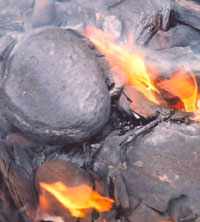Petrosix is the world’s largest surface oil shale pyrolysis retort with an 11 metres (36 ft) diameter vertical shaft kiln, operational since 1992. It is located in São Mateus do Sul, Brazil, and it is owned and operated by the Brazil energy company Petrobras. Petrosix means also the Petrosix process, an externally generated hot gas technology of shale oil extraction. The technology is tailored to Irati oil shale formation, a Permian formation of the Paraná Basin.

The history of the oil shale industry started in ancient times. The modern industrial use of oil shale for oil extraction dates to the mid-19th century and started growing just before World War I because of the mass production of automobiles and trucks and the supposed shortage of gasoline for transportation needs. Between the World Wars oil shale projects were begun in several countries.

Queensland Energy Resources Limited (QERL) is an Australian oil shale mining and shale oil extraction company with the headquarters in Brisbane. It is the developer of the Stuart (Yarwun) and McFarlane oil shale projects.
The American Shale Oil, LLC (AMSO), originally known as EGL Oil Shale, LLC, was a developer of in-situ shale oil extraction technology based in Rifle, Colorado. It was owned by Genie Energy and Total S.A.. In May 2016, Genie Energy announced that the AMSO project was closing.
Ambre Energy Limited is an Australian coal and oil shale company. It has offices in Brisbane and Salt Lake City.
The Kiviter process is an above ground retorting technology for shale oil extraction.
The TOSCO II process is an above ground retorting technology for shale oil extraction, which uses fine particles of oil shale that are heated in a rotating kiln. The particularity of this process is that it use hot ceramic balls for the heat transfer between the retort and a heater. The process was tested in a 40 tonnes per hour test facility near Parachute, Colorado.

The Galoter process is a shale oil extraction technology for a production of shale oil, a type of synthetic crude oil. In this process, the oil shale is decomposed into shale oil, oil shale gas, and spent residue. A decomposition is caused by mixing raw oil shale with a hot oil shale ash, generated by combustion of carbonaceous residue (semi-coke) in the spent residue. The process was developed in 1950s and it is used commercially for the shale oil production in Estonia. There are projects for further development of this technology and for expansion of its usage, e.g. in Jordan and USA.
The Lurgi–Ruhrgas process is an above-ground coal liquefaction and shale oil extraction technology. It is classified as a hot recycled solids technology.
The gas combustion retort process was an above-ground retorting technology for shale oil extraction. It was a predecessor of the Paraho and Petrosix processes, and modern directly heated oil shale retorting technologies in general.
The Nevada–Texas–Utah retort process was an above-ground shale oil extraction technology to produce shale oil, a type of synthetic crude oil. It heated oil shale in a sealed vessel (retort) causing its decomposition into shale oil, oil shale gas and spent residue. The process was developed in the 1920s and used for shale oil production in the United States and in Australia. The process was simple to operate; however, it was ceased from the operation because of a small capacity and labor extensiveness.
The Superior multimineral process is an above ground shale oil extraction technology designed for production of shale oil, a type of synthetic crude oil. The process heats oil shale in a sealed horizontal segmented vessel (retort) causing its decomposition into shale oil, oil shale gas and spent residue. The particularities of this process is a recovery of saline minerals from the oil shale, and a doughnut-shape of the retort. The process is suitable for processing of mineral-rich oil shales, such as in the Piceance Basin. It has a relatively high reliability and high oil yield. The technology was developed by the American oil company Superior Oil.
The Union process was an above ground shale oil extraction technology for production of shale oil, a type of synthetic crude oil. The process used a vertical retort where heating causes decomposition of oil shale into shale oil, oil shale gas and spent residue. The particularity of this process is that oil shale in the retort moves from the bottom upward to the top, countercurrent to the descending hot gases, by a mechanism known as a rock pump. The process technology was invented by the American oil company Unocal Corporation in late 1940s and was developed through several decades. The largest oil shale retort ever built was the Union B type retort.
The Chevron STB process is an above-ground shale oil extraction technology. It is classified as a hot recycled solids technology.
The Hytort process is an above-ground shale oil extraction process developed by the Institute of Gas Technology. It is classified as a reactive fluid process, which produces shale oil by hydrogenation.
The Shell Spher process is an above ground fluidization bed retorting technology for shale oil extraction. It is classified as a hot recycled solids technology.
There are oil shale deposits in Australia which range from small deposits to large reserves. Deposits, varying by their age and origin, are located in about a third of eastern Australia. In 2012, the demonstrated oil shale reserves were estimated at 58 billion tonnes. The easiest to recover deposits are located in Queensland.
The history of the oil shale industry in the United States goes back to the 1850s; it dates back farther as a major enterprise than the petroleum industry. But although the United States contains the world’s largest known resource of oil shale, the US has not been a significant producer of shale oil since 1861. There were three major past attempts to establish an American oil shale industry: the 1850s; in the years during and after World War I; and in the 1970s and early 1980s. Each time, the oil shale industry failed because of competition from cheaper petroleum.





